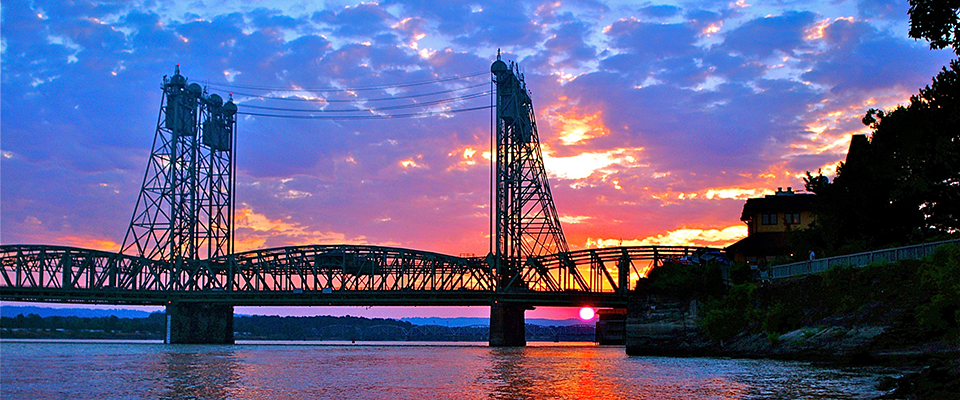Spotlight: Gateway to Washington
Find Evergreen State wonders just off the interstate
The stretch of Interstate 5 that runs from Vancouver to Olympia in Washington is a scenic journey through some of the state’s most stunning natural beauty.
The obvious place to start is the city of Vancouver, located between the Pacific Ocean and the Cascade Mountains just across the border from Portland, Oregon. Its proximity to abundant freshwater makes this town a prime destination for sport fishing. The Columbia River is home to steelhead, coho and chinook salmon. Battling a 20-pound fish is a sport fisherman’s dream tale to tell, and the fall salmon run beckons fishing enthusiasts by the hundreds.
Back on dry land, visit historic Fort Vancouver and step back in time to the days of fur traders and frontier life. The reconstructed fort is home to working trade houses dedicated to baking, carpentry and blacksmithing. Grab a bite at The Grant House, the oldest residence in the city and the namesake of former fort quartermaster and U.S. president, Ulysses S. Grant.
Vancouver’s thriving arts scene encompasses live musical performances from the city’s symphony orchestra and a popular Polynesian festival celebrating the heritage of the Hawaiian residents. In the summer, the Pavilion at Esther Short Park welcomes audiences to outdoor concerts.

© 2008 Bill Alley
On the Wild Side
Sauvie Island is where bird hunters go to bag pheasant, dove, Canada goose and quail. This island, nestled in the middle of the Columbia River, receives more than 1 million visitors each year—many of whom flock to the island for its beaches, bike trails and boating opportunities. Bird-watchers enjoy sighting any of the more than 250 species that call the island home. Once the residence of Multnomah Indian tribes, the island is dedicated to wildlife preservation and farming as well as outdoor recreation.
Ridgefield National Wildlife Refuge rests on the banks of the Columbia River just north of Vancouver. It provides a wintering habitat for Canada goose subspecies and is home to neo-tropical songbirds and other native species. The refuge also preserves what’s become the most intact archeological site on the lower portion of the river. The history and culture of the people who occupied this region for nearly 2,300 years are displayed at the Cathlapotle Plankhouse, which is open to visitors on weekends in spring and summer.
Castle Rock, known as the gateway to Mount St. Helens, earned its moniker from an impressive 190-foot-high monolith that once served as a landmark for fur traders and local tribes. Today, the town is a destination for outdoor recreation such as hiking, boating, hunting and fishing. The town’s historic district is a prime spot for antiques shopping, gifts and locally sourced works of art. The Castle Rock Exhibit Hall and Visitors Center details the impact of the volcano’s eruption on the region, and role of the logging industry in the development of the town.
See Mount St. Helens from the inside—sort of—at the Visitor Center at Silver Lake. This award-winning educational center features a step-in model of the volcano as well as interactive exhibits and theater programs. Mount St. Helens is part of the Gifford Pinchot National Forest, which covers more than 1.3 million acres and includes river valleys and waterfalls alongside the national volcanic monument. Known for its devastating 1980 eruption. Mount St.

Vancouver USA
Mountain Sports
The town of Rainier celebrates the majesty of its namesake peak with heritage train rides and a railway museum, scenic driving tours and cross-country skiing trails. Mount Tahoma Trails hosts skiers in winter and hikers in summer, both of whom can traverse the paths that wind through the ridges and valleys of the Cascade range.
One of the most popular driving tours is the route circling Mount Rainier. At 78 miles long, the drive offers views of Mt. Rainier’s snow-covered ridges and old-growth rainforests, as well as waterfalls and scenic vistas. Stops include Skate Creek for fall color displays. A stop at Longmire rewards visitors with a stunning shot of the mountain and views of the 40-foot Christine Falls.
Centralia’s settler history is the backdrop for Fort Borst Park. Here, visitors can explore a replica of a one-room school house, a homestead and the Fort Borst Blockhouse, a hand-hewn log structure that was used to store grain. Get some fresh air at Seminary Hill, an urban natural space with more than 2 miles of trails that overlooks the town and the Chehalis and Skookumchuck River Valleys.
For More Information





